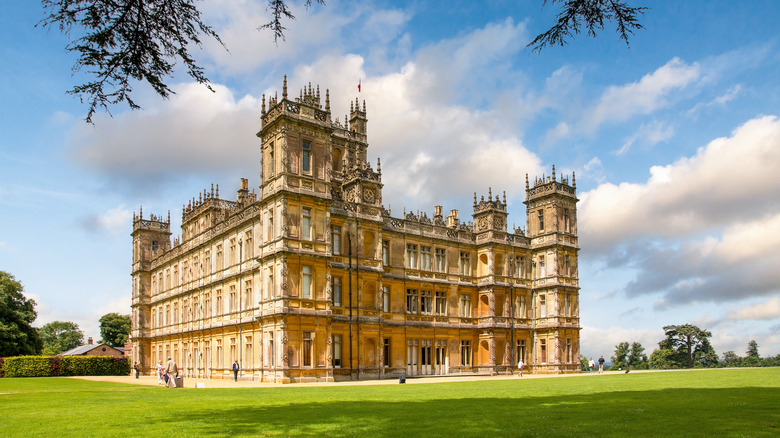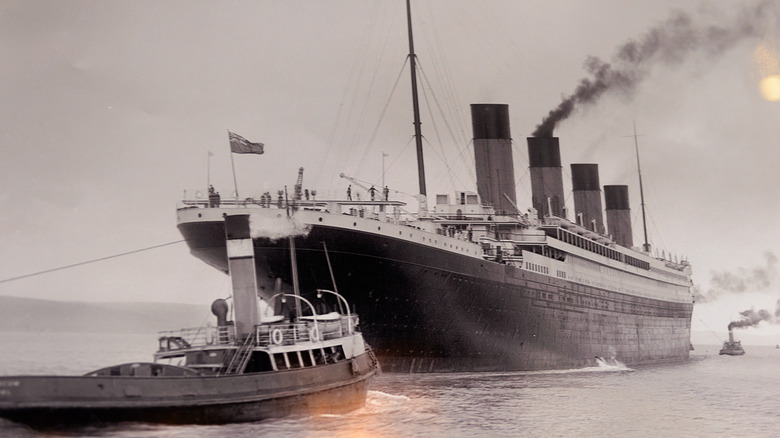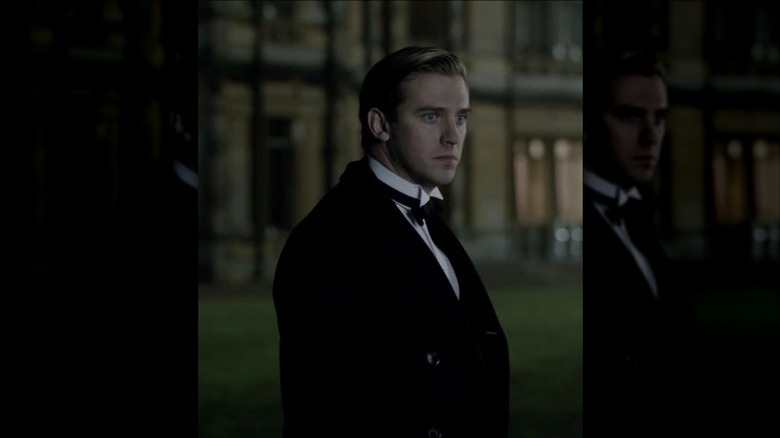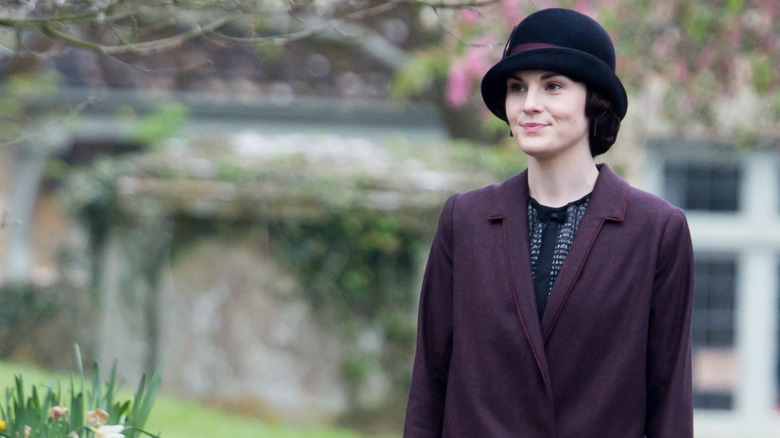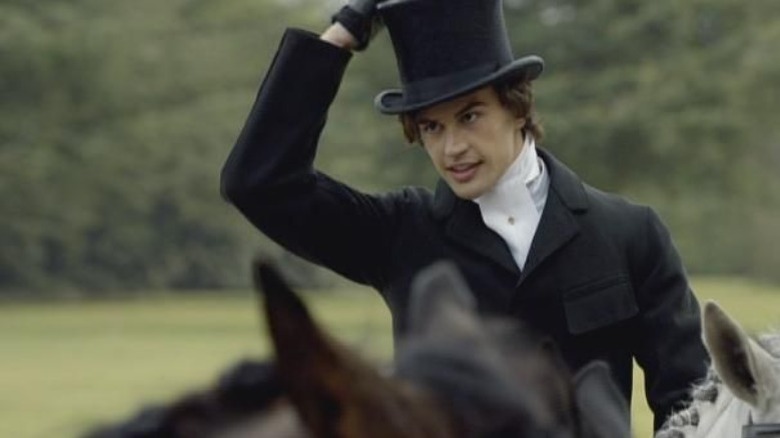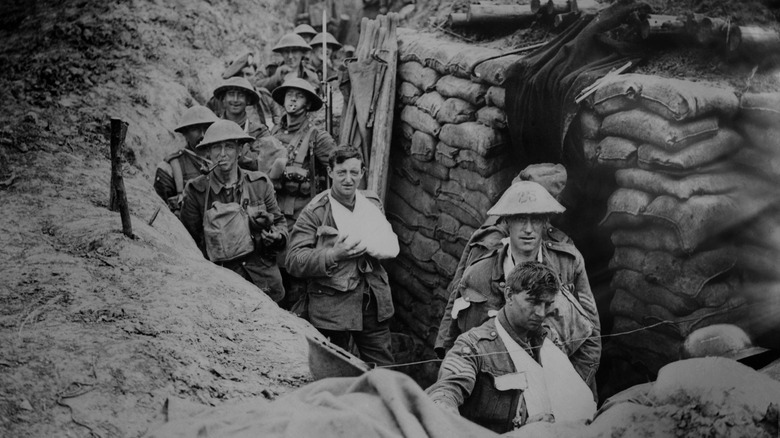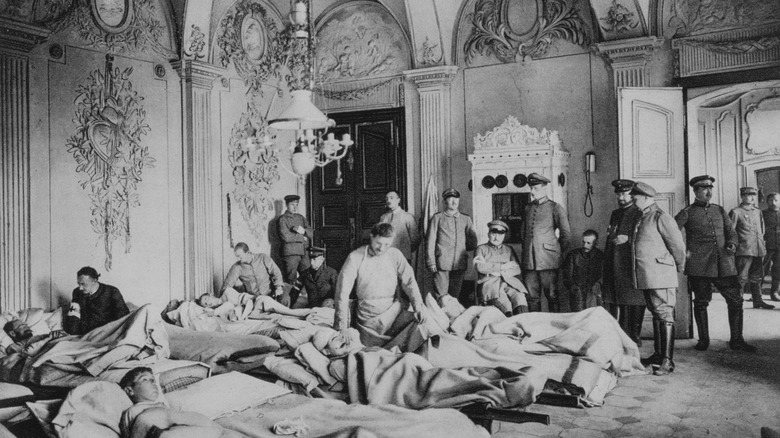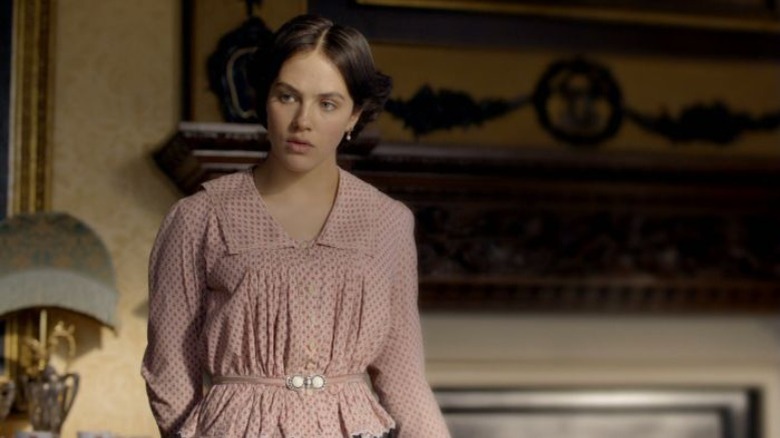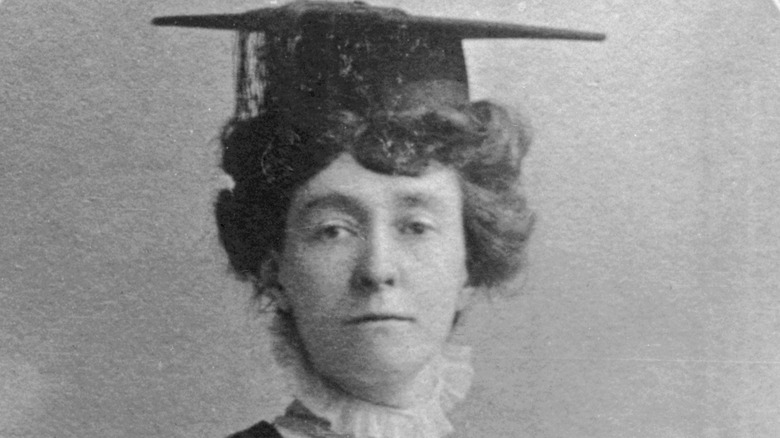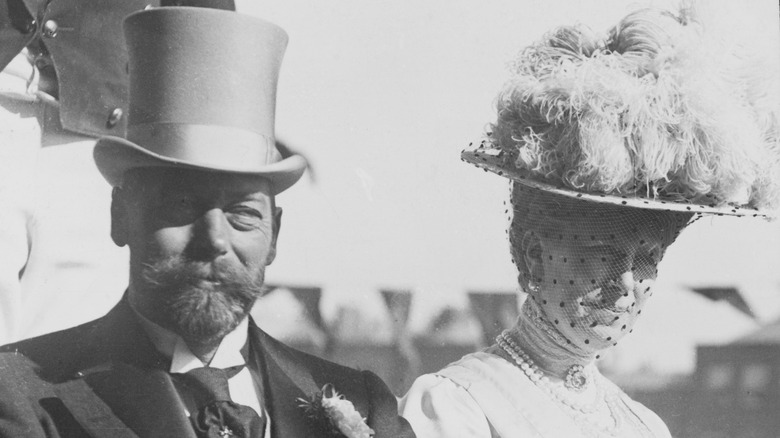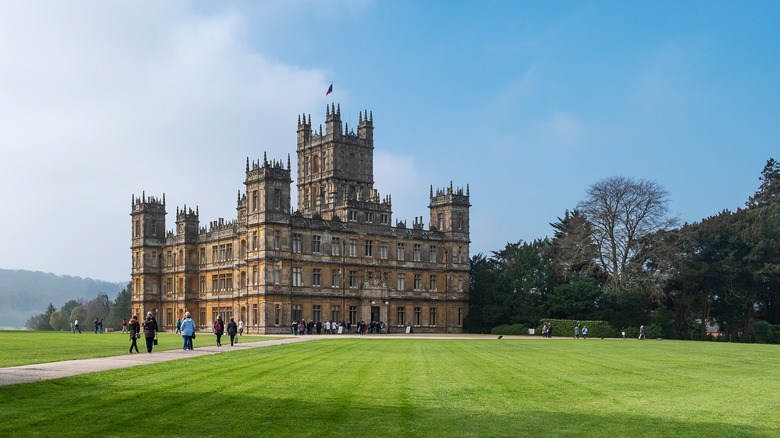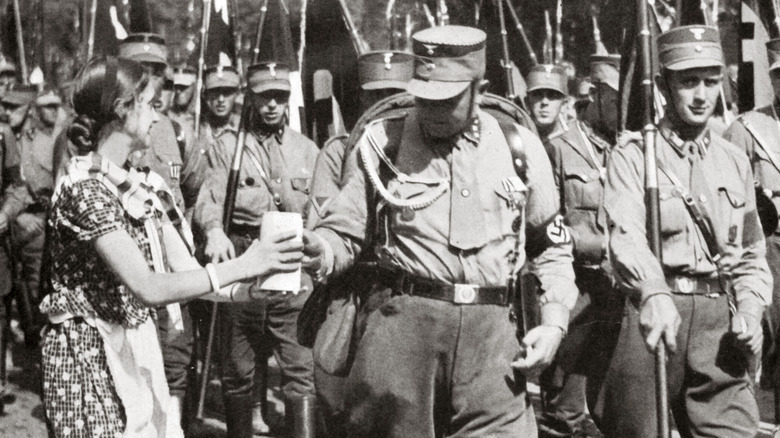Times Downton Abbey Got History Right
The historical fiction genre depicts things that could have happened and people who could have lived but didn't, or things that did happen and people that did live, but with personalities and events tweaked to better suit the narrative. The genre is at its very best when the depiction of people, places, and events read like the genuine article but the story taking place is still drama-filled and wild.
And when you think about it, the beloved show "Downton Abbey" was certainly drama-filled and often rather wild. There were tragic deaths, touching births, and torrid affairs; there was intrigue and blackmail; there was a shipwreck, a murder trial, a war; there were advances in technology and changes in culture. And on and on it went for six seasons and a follow-up feature film (with another in the works).
The reason the show worked so well was that for all the drama and the oft wild twists and turns, the show did an overall good job at historical accuracy. Certainly, critics have pointed out this or that inconsistency (like one critical flaw: the patrician family would never have had such close contact with the lower echelon of servants) but overall "Downton Abbey" did an admirable job of weaving fiction into history.
The sinking of the Titanic
The first episode of "Downton Abbey" commences immediately following news of the sinking of the H.M.S. Titanic. In the show, the family is devastated both due to the sheer loss of life and shock of the sinking of the so-called "Unsinkable Ship" and also because, in a fictional twist, down with the Titanic have gone the presumptive heirs of the estate of Robert Crawley, a.k.a. the 7th Earl of Grantham. We also see shock and sadness among others, including the servants of Downton Abbey, for whom the sinking is less a matter of patronage and more a tragedy, pure and simple.
The heavy-heartedness with which the characters of the show react to the sinking of the Titanic is very much in keeping with the way things really were. April 15, 1912, the date of the sinking, was to be for the United Kingdom a date much like December 7, 1941 or September 11, 2001 for the United States: an infamous date long remembered with sorrow. According to the BBC, some communities in England lost dozens of people in the tragedy, while one, Southampton, lost hundreds. That's because more than 700 of the crew of some 900 people hailed from the city. In all, approximately 1,500 people died when the mighty ship sank, while only 706 people are known to have survived, according to History.com.
(And in an interesting sidebar, "Downton Abbey" creator Julian Fellowes took the director of the smash hit "Titanic" James Cameron to task for historical inaccuracies in his 1997 film, a movie that reignited a fascination with the tragedy, via Today.)
Women could not inherit estates
In "Downton Abbey," after the very real sinking of the Titanic was supposed to have killed off the fictional heir of Robert Crawley, Earl of Grantham, the role of Matthew Crawley, his cousin (once removed by a generation) became all-important. This was because Matthew became the heir-apparent of the title of Earl of Grantham and the would-be head of Downton Abbey. This might seem odd to us today, as Robert and Cora Crawley had three daughters: Mary, Edith, and Sybil. But up until 1925, the U.K. had a primogeniture law on its books.
According to the Legal Information Institute of Cornell Law School, "primogeniture is a system of inheritance in which a person's property passes to their firstborn legitimate child upon their death [and] historically primogeniture favored male heirs, also called male-preference primogeniture. Under this regime, the eldest living son would inherit the entirety of his parent's estate."
According to Landesa, the importance of Matthew Crawley to the family could hardly be overstated; in early-20th century Great Britain, women could not inherit titles and property. If a single male heir was known to exist, be he a son or a more distant relation, he was the heir. So without a designated male heir, the succession of the earldom and ownership of Downton Abbey was in question and would have been a mess had Robert Crawley died before things were rearranged.
The costumes were spot on
The costume designers working on "Downton Abbey" had at their disposal quite a useful tool: photographs. Lots of photographs. Being set in the early decades of the 1900s, the show takes place at a time when photography was already well-established, and what's more, the English aristocracy was frequently photographed. When you compare images taken of real English men and women from the WWI era with the outfits worn on the show, you'll see a wonderful verisimilitude was created. And it was done so through painstaking work: some of the outfits worn in the "Downton Abbey" movie, for example, required months of work, as one costume designer relayed to Town & Country.
Another challenge the costumers faced and ably met were the changes in style that took place during the time that elapsed during the show. From the year 1912, when the story commences, into the 1920s, clothing changed markedly, especially in terms of the way women dressed. Whereas in the early seasons, women's clothing was by and large conservative and demure, by the later episodes many of the dresses worn by the daughters of Downton, Lady Mary and Lady Edith, as well as by their friends and relations, were more revealing, heavily bedazzled, and a marked break from the sartorial mores of the Edwardian Era of the start of the show.
Kemal Pamuk was inspired by real-life events
The brief storyline on Downton Abbey involving Kemal Pamuk, a Turkish diplomat portrayed by British actor Theo James, seemed a bit hard to believe. Dashing and mysterious and a bit creepy, too, Pamuk, who is visiting Downton Abbey as a side trip during an ambassadorial mission to London, engages in secret sexual liaisons with Lady Mary Crawley only to die of a heart attack while in her bed.
Seems far-fetched, no?
Well, in fact, the entire storyline was inspired by real events. According to CBR, Julian Fellowes, creator of the show, explained that he and a friend, a member of Britain's so-called "high society," had unearthed a journal penned by a long-dead great aunt sometime in around 1890 in which indeed a young foreign diplomat died in the bed of a high born young lady. The mysterious death took place at a grand estate much like Downton Abbey, and as depicted in the show, the family reportedly smuggled the dead body from the girl's bedchamber and dropped it back into the room the young man had been given, where it was later found by others. The incident was cross-referenced against another diary kept by a different family member in which the death is recorded, but in that case without knowledge of the moving of the corpse or the dalliance that preceded it.
Some aristocrats really did serve in WWI
More often than not, wars are fought by young men of less-than abundant means, at least when it comes to frontline service. And while many a poorer young man from the lower classes of British society found himself going "over the top" of the WWI trenches at Verdun or the Somme or any of the other long, awful battles of that long, ghastly war, indeed some member of English aristocracy did fight right at the front as well. Such was depicted in Downton Abbey when young Matthew Crawley fought right down in the mud, as it were, even meeting Downton servant Thomas Barrow in the trenches.
As evidence that this was art imitating life, look no further than the service of the future King Edward VIII, who, according to War History Online, was so eager to fight at the front that he begged his father for a dispensation to be allowed to take part in the war. He joined the Grenadier Guards and, while usually held back from real combat, the heir to the throne and future king did indeed get to the front lines often enough to earn the respect of his fellow soldiers.
And even as Edward made frequent trips to the forward trenches, his younger brother, Albert, also eventual king of England (as George VI), was serving in the Royal Navy as a midshipman and saw battle at sea, including experiencing torpedoes missing his ship by a matter of 30 feet or so.
Estates like Downton Abbey were used as hospitals during WWI
In some of the more moving scenes to come out of the entire "Downton Abbey" series, war comes home, as it were, when the stately Abbey is converted into a location caring for soldiers wounded in the fighting of World War I. This was no flight of fancy on the part of the show's writers, but in fact, it was a common occurrence at the time. Many royal homes like the fictional Downton Abbey were actually used as hospitals and convalescent homes during the Great War, including the very real Highclere Castle, the stately residence depicted as Downton Abbey in the show, according to Highclere Castle's own site.
Throughout the war years, Highclere was used as a convalescent home for wounded soldiers, with Lady Almina, wife of the 5th Earl of Carnarvon (real holders of the seat portrayed fictionally as Grantham) overseeing the operation. She was at times called "the Florence Nightingale of her day," according to the tabloid the Daily Mail, for the level of care and attentiveness she paid her charges. The care the men received even included advanced surgical procedures thanks to facilities established in the grand home.
In "Downton Abbey," we primarily see Lady Sybil, youngest of the Crawley daughters, take to nursing the wounded young men who arrive at Downton.
Death in childbirth was common
The tragic death of Lady Sybil, youngest of the three Crawley daughters, may have come as a shock to viewers of "Downton Abbey," but it was hardly a shock to those working on the show. Actor Jessica Brown Findlay, who portrayed the young royal, had declared her intention to remain on the show for a maximum of three seasons right from the start, according to Hello Magazine. Thus show creator and writer Julian Fellowes had long planned for her story arc to end in death. And the cause of the death itself was one that was still all too common even in the second decade of the 20th century: childbirth. Or complications arising from birth, that is.
Lady Sybil died as a result of eclampsia, which, according to Health Line, "is a severe complication of preeclampsia. It's a rare but serious condition where high blood pressure results in seizures during pregnancy." And for the record, also via Health Line: "Preeclampsia is when you have new onset high blood pressure and at least one associated symptom, such as protein in your urine, during pregnancy or after delivery."
The show teased Sybil's symptoms with accuracy, according to All That's Interesting, and while treatments for the condition were coming into use in the early 20th century, many women were still dying from eclampsia and many more from other complications of childbirth. In fact, according to NCBI, British maternal mortality rates in the 19-teens were about the same as they had been for the preceding half-century, and they would not drop much for another generation.
Suffragette Emily Davison was a real and tragic person
Before her death, Lady Sybil was growing into a passionate political thinker, partially inspired by the ideals of her secret husband, Irishman Tom Branson, and largely by women partaking in the movement for women's suffrage. One such person mentioned in the show was suffragette Emily Davison, whose name came up as a specific inspiration for Sybil.
Emily Davison was a real person and an inspiration to millions, which is little surprise, given her life story. Born in 1872 to a wealthy businessman father and a lower-class housekeeper mother who was 28 years younger than he, according to Smithsonian Magazine, Davison's upbringing started off in a Downton-like upstairs/downstairs life until the initially surreptitious couple married and her parents could live openly. When her father died, Davison, 20 at the time, found family finances largely dwindled and took a number of jobs over the years, caring for children of wealthy families and later focusing on education. Inspired by suffragist meetings she attended starting in 1906, Davison became a passionate activist, moving to full-time activism by 1909.
The suffragette was arrested multiple times for her activities, which included breaking into the Houses of Parliament, the seat of the government she was up against. In prison, she went on hunger strikes and endured awful forced feedings. In a final act of protest, Davison ran out onto a racetrack and was struck by a horse owned by King George V himself. She would die of the injuries a few days later on June 8, 1913, via Britannica.
The king and queen did pay visits to aristocrats' houses
The "Downton Abbey" movie, which was released in 2019 and simply called "Downton Abbey," was a continuation of the series. Set in the year 1927, the feature film's plot is centered on a royal visit to Downton Abbey, a visit announced by King George V and Queen Mary with relatively little time for the Crawley family and their staff to prepare in proper style for such an august occasion. In the film, there is petty drama as royal staff squabble with Downton staff (and as one royal maid steals various items from Downton), there is high-class tension, there is an assassination attempt, and on it goes.
Attempted regicide, snide one-liners, and romantic ups-and-downs aside, royal visits to homes like the one depicted in "Downton Abbey" were indeed a huge deal in England at the time. In fact, the fictional 1927 visit is largely based on a real famed visit paid by King George and Queen Mary to the Wentworth Woodhouse, according to The Yorkshire Post. The royal visit to Wentworth Woodhouse took place in 1912 and pictures of and reports about that visit were closely studied by Downton's producers, writers, and director as they created their fictional version of similar events.
The estate's money woes were a sign of the times
At first glance, anyone looking at the stately manor of Downton Abbey and the lavish lifestyle of the family that lived there would assume the Crawleys were utterly flush with cash. But as we learn time and again during the course of the show, in fact, the Earl of Grantham is right to be worried about money: Downton is often teetering on the brink of destitution. This comes, according to CNN Money, from a variety of reasons, including a poor investment the earl makes in a railroad company in Canada, lack of clear plans for an inheritance, and continued mismanagement of the land of the estate.
The money woes depicted in the show were all too real for all too many stately British homes in the early 20th century. The crushing costs of maintaining such homes ran up against the changing times, in which less revenue came in from inherited land ownership alone, and would lead to a veritable epidemic of so-called lost English country homes. According to Lost Heritage, some 1,984 stately country homes around the U.K. have been "lost" in the past century and a half or so, many of them abandoned, not repaired after a fire or other damage, or even proactively demolished. The illusion of a graceful, refined life often fell apart in the face of the same troubles people of all heritage and class face: money troubles.
Nazi SA thugs were active
One of the more tragic plotlines from "Downton Abbey" takes place entirely off-camera. It is the disappearance and eventually confirmed death of Michael Gregson, the boss who becomes the lover of Edith Crawley, and who fathers a child with her whom he will never meet and she will be forced to give away to be raised by another family who she pays in secret. The romance between Edith and Gregson is real, and his feelings for her seem genuine, so his disappearance is a great confusion to the middle Crawley sister, who pines for her lost partner fruitlessly for months.
We later learn that Gregson, a newspaper owner, certainly didn't run off on Edith; he was killed in Germany during the Beer Hall Putsch, according to Britannica. He was murdered by a group of violent political agitators who are described as wearing "brown shirts," who were members of the Sturmabteilung, or SA, also known as the Brown Shirts. The SA was the paramilitary arm of the fledgling Nazi party, and this group of political thugs was indeed responsible for many deaths and many more injuries (and destruction of property and disruption of the peaceful flow of state politics) during just the years in which the show places Gregson's death.
